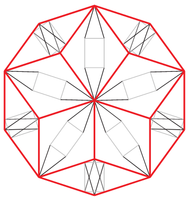-
Content Count
29 -
Joined
-
Last visited
Content Type
Profiles
Forums
Gallery
Everything posted by technicmath
-

Gears-efficient gearbox
technicmath replied to technicmath's topic in LEGO Technic, Mindstorms, Model Team and Scale Modeling
Indeed. @LegoTT What exactly do you mean with 300% and 500% with the 24 tooth gear of an old diff? I built a sequential version of the above 4 speed gearbox. There need to be 2 additional orange changeover catches, 2 driving rings and 2 blue 20 tooth idler gears (instead of the tan 20 tooth gear in the picture). The two grey angle #2 connectors need to be replaced by the smooth axle connector for the driving ring. The distance between the two drive axles is 7*2/5=2.8 studs, which is better than the 2.828 studs, but not as good as the 2.773 studs. Note the usage of 5.5 axles. -

Gears-efficient gearbox
technicmath replied to technicmath's topic in LEGO Technic, Mindstorms, Model Team and Scale Modeling
Thank you Attika. @Gray Gear As described in the first post, the desired distance between the gears is 2.75 studs. On a studless grid, even with considering half-stud lengths, the closest approximation that fits is a distance of 2 studs in one direction and 2 studs in a perpendicular direction as in nicjasno's original design (see link in the first post). This gives a distance of sqrt(2^2+2^2) or approximately 2.828 studs. As described in the first post, using the design with technic bricks gives a distance of sqrt((3*2/5)^2+2.5^2) or approximately 2.773 studs, which is much closer to the desired 2.75 studs. This is really worth it. You can align the 1 x 4 technic brick with a studless liftarm, then the axle going through this 1 x 4 technic brick fits in the studless grid. The axle going through the 1 x 2 technic brick with 2 holes is not aligned with the studless grid, but using for example a gear combination 20/24 you can with the same design land in the studless grid again. @Touc4nx The construction with the red perpendicular connectors gives the distance of sqrt(2^2+2^2) studs, which pleegwat already answered. -

Gears-efficient gearbox
technicmath replied to technicmath's topic in LEGO Technic, Mindstorms, Model Team and Scale Modeling
Thank you nicjasno! Here is a picture of the concept: The old driving ring needs to be replaced by the new driving ring and the two 28 tooth gears are missing. In this 4 speed gearbox the gears are 16/28 approx 0.57 20/24 approx 0.83 24/20=1.2 28/16=1.75. Thus the ratios between the gears are 0.83/0.57 approx 1.46 1.2/0.83 approx 1.44 1.75/1.2 approx 1.46. Since sqrt(1.44)=1.2, a gearing of 1.2 will give intermediate gears to obtain an 8 speed gearbox. Thus the 4 gears of the above 4 speed gearbox are gears 1, 3, 5 and 7. By using the gearing of 1.2 in combination with this 4 speed gearbox you obtain gears 2, 4, 6 and 8. Then a 2 speed gearbox with a ratio of 1.2 between the 2 gears is needed. This can be done for example by (16 with clutch/16)x(12/24) and (20 with clutch/16)x(8/24) or (16 with clutch/20)x(24/8) and (16 with clutch/16)x(24/12) or (16 with clutch/20)x(12/24) and (16 with clutch/16)x(8/24) https://bricksafe.com/files/technicmath/gearbox/Gearbox2.png or other similar combinations. Then the 8 speed gearbox has approx these gears: gear 1: 0.57 gear 2: 0.57*1.2=0.684 gear 3: 0.83 gear 4: 0.83*1.2=0.996 gear 5: 1.2 gear 6: 1.2*1.2=1.44 gear 7: 1.75 gear 8: 1.75*1.2=2.1. In this 8 speed gearbox, the average ratio between successive gears is approx 1.2 and the ratio between the highest and lowest gear is 2.1/0.57 approx 3.68. This gives smaller gaps than in for example set 42110: 4 gears 1:5 ; 1:3 ; 1:1,67, 1:1 (according to techlug review) => average ratio between successive gears is 1.71 and ratio between highest and lowest gear is 5 set 42083: 8 gears 1:1,67 ; 1:1,25 ; 1:1 ; 1:0,8 ; 1:0,6 ; 1:0,45 ; 1:0,36 ; 1:0,29 (according to techlug review) => average ratio between successive gears is 1.28 and ratio between highest and lowest gear is 5.76.

